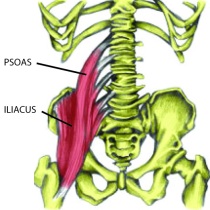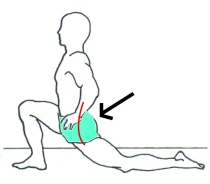The one downside this job has is seeing the huge amounts of pain people walk – or more often, hobble – into my clinic in. As much as a lot of injury treatments can be somewhat at the ‘uncomfortable’ end of the pain scale, we “Therapists” honestly (genuinely!) dont enjoy other peoples pain, and so I always try to get people with lower back pain (LBP) in as soon as possible, as I know how debilitating it can be. There are, as always, a huge range of possible causes of LBP, which I will look at individually over the coming months. In this blog I am going to concentrate on one group of muscles that pop up over and over again; the hip flexors.
What are the hip flexors?
Numerous muscles flex the hip (bring your knee up from the hip), but the two that are most commonly referred to as ‘the’ hip flexors are the group made up of the Psoas and the Iliacus – called the Illiopsoas. These are two deep muscles which attach at the top of the inside edge of the thigh bone; the Psoas ends at the Lumbar Verterbrae (lower back); the Iliacus ends on the Iliac crest.
Alongside their role in flexing the hip (walking, running), they are also a major player in lower back stabilty, enabling good standing posture.
What happens?
Current lifestyles mean a lot of us spend long parts of the day sat down, be that at the desk at work, driving, or sat watching t.v. This means that the hip sits at 90 degrees – or flexed – for long periods. The iliopsoas is built up of slow twitch muscle fibres, and when sat dormant in this contracted (or shortened) state they can begin to accept it as the ‘norm’. It is not only sedentary lifestyle that can have negative effects on this group of muscles though, and because of its huge work load when walking, running etc it can be suseptible to overuse. Eventually the tight psoas will begin to pull on the spinal attachments, potentially tilting your pelvis, and ultimately causing pain. In some cases lordotic curvature of the lumbar region will occur – also known as ‘duck butt’!
A shortened Psoas on one side will pull the spine to that side, potentially leading to scoliosis (bending) of the spine, and a noticeable imbalance.
A tight Psoas can also inhibit the Glutes firing and performing normally. This is called Reciprocal Inhibition (the Psoas and the Glutes are opposing muscles).
Symptoms
To go back to the start of this blog, the primary sign of an iliopsoas injury, or issue, is pain in the lumbar spine area. It can be painful and difficult to stand up after long periods of hip flexion (after driving, seated at a desk, or even sleeping in a ‘fetal’ position), or sitiing up from a led down position.
In some cases pain through the groin region will also be present.
If when laying flat on your back you can fit your hand under your lower back – you may have iliopsoas tension.
Treatment
To get these muscles working to their full effect, we need to utilise them in their full range of movement. To enable this requires stretching of the muscle, both statically and dynamically, and through skilled massage techniques. Because of the deep location of these muscles, a highly trained Therapist will relax the superficial muscles to enable palpation of the Psoas, and in some cases, the iliacus. I have found that techniques such as Soft Tissue Release can be highly effective and in some cases, result in instant relief (see http://www.dc-injuryclinic.co.uk/sport.html for more information on how Sports Massage can help).
Self Help
A simple test of hip flexor tension is to lie on your back, and hug your knees to your chest. Let one leg go, and gently lower it straight. If your leg ‘hangs’ in the air and doesnt lie flat on the ground – you may have hip flexor tension. An easy stretch to start correcting the problem is in the lunge position as shown in the below picture.
N.B. There are no ‘one size fits all’ style quick fixes in most injury scenarios, so these article shouldnt be seen as such. They are merely guides to a better understanding of how our bodies work.
For more information please visit www.dc-injuryclinic.co.uk



Leave a comment